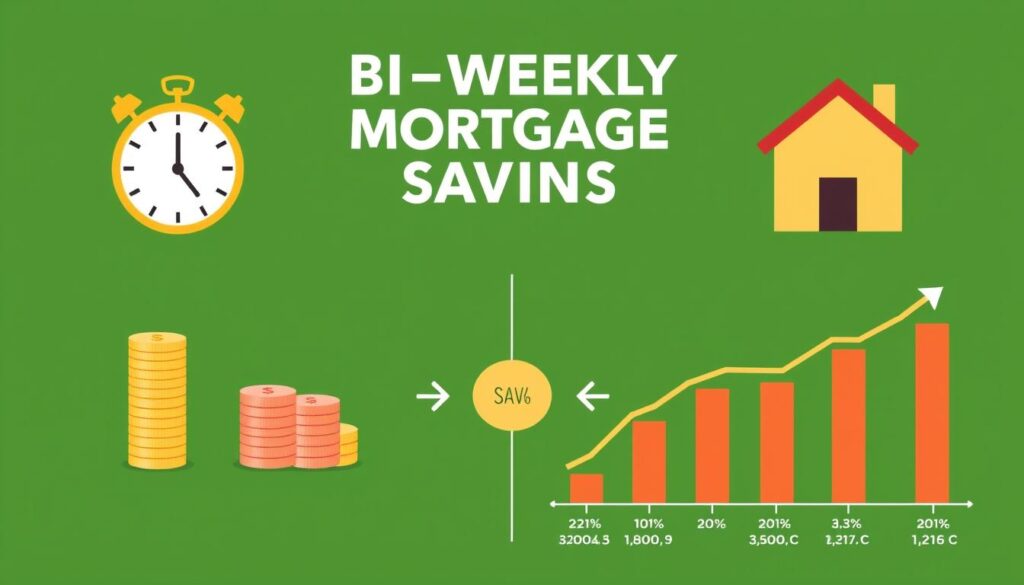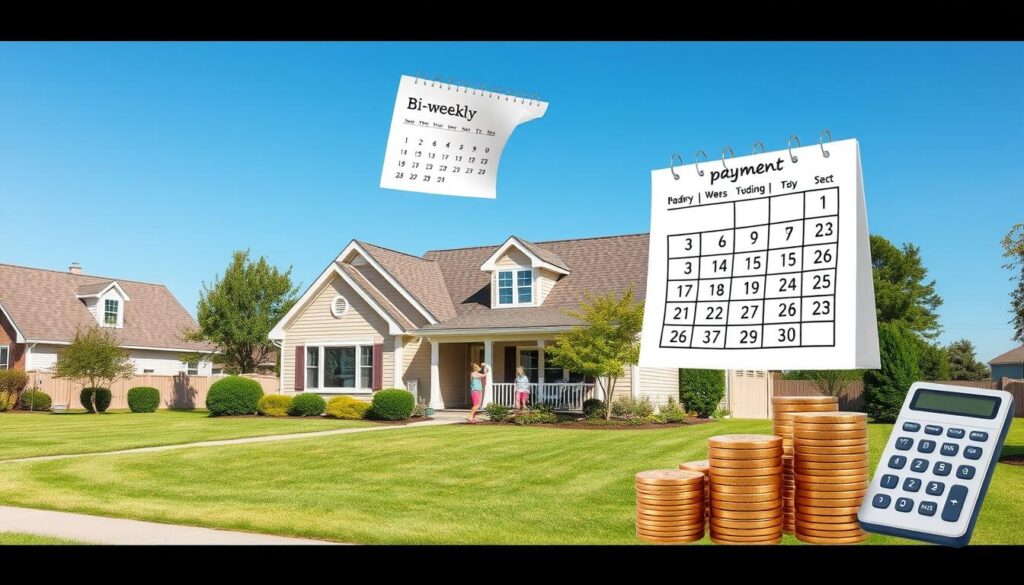We often seek out ways to free ourselves from debt more swiftly and to save money along our financial journey. Bi-weekly mortgage payments stand as a beacon of efficiency in this endeavor. With each passing two weeks, we find ourselves one step closer to the satisfaction of a fully paid home. And as the numbers suggest, the benefits are hardly insignificant. Could the simple act of restructuring how we pay our mortgage unlock doors to substantial savings? Let’s delve into the method that could allow us to bid farewell to our mortgage debt years in advance and retain more of our hard-earned dollars.
Key Takeaways
- Accelerate mortgage payment frequency to bi-weekly and potentially pay off your home 6-8 years earlier than with monthly payments.
- Enjoy the equivalent of one extra mortgage payment per year without drastic changes to your budget.
- A bi-weekly payment could lead to over $220,000 in interest savings on a $500,000 30-year mortgage.
- More of your payment goes towards the principal, reducing interest faster and building equity sooner.
- Save with bi-weekly payments by carefully navigating lender terms and avoiding intermediary fees.
- Embrace the flexibility of bi-weekly payments across different mortgage types, from fixed to adjustable-rate mortgages.
- Pairing bi-weekly payments with refinancing could multiply savings during periods of low mortgage rates.
Understanding Bi-Weekly Mortgage Payments
When exploring innovative solutions for accelerating your mortgage payoff and reducing long-term costs, many homeowners consider transitioning from monthly payment schemes to more frequent, bi-weekly mortgage payments. Altering the frequency of your payments can significantly impact the duration of your loan and the total interest payable. But what exactly does this method entail, and how does it compare with traditional monthly payments?
Typically, a standard monthly mortgage payment plan requires 12 payments per year. On the other hand, a bi-weekly mortgage payment scheme involves making payments every two weeks, totaling 26 half-payments—or 13 full payments—each year. This seemingly slight adjustment can yield significant financial benefits owing to the nature of compound interest calculations on mortgages.
This payment strategy, by using the potency of bi-weekly vs monthly payments, allows you to accelerate mortgage payment schedules subtly yet effectively. Over time, this acceleration contributes to more rapid equity building and reduced interest costs. For instance, on a typical $200,000 home with a 30-year fixed-rate mortgage, adopting a bi-weekly payment method might save you up to $18,703 in interest, slashing nearly five years off your mortgage term.
| Payment Method | Total Payments Per Year | Potential Interest Savings | Years Shaved Off Loan |
|---|---|---|---|
| Monthly | 12 | 0 | 0 |
| Bi-Weekly | 13 (equivalent) | $18,703 | 5 |
Beyond the benefits, it’s paramount to consider potential drawbacks. Initially, not all mortgage payment plans are amenable to adjustments. Moreover, some lenders might levy additional fees for restructuring your payment plan to bi-weekly, somewhat offsetting the savings. Therefore, it’s advisable to converse with your mortgage provider about the feasibility and potential expenses associated with switching to a bi-weekly schedule.
Ultimately, a perfectly tailored mortgage payment plan isn’t just about affordability. It’s also about strategic financial planning, enabling homeowners to accelerate mortgage payment schedules and achieve long-term monetary goals. It’s crucial to weigh the long-term benefits of additional payments against potential fees or changes in your financial situation.
Maximizing Savings with Bi-Weekly Payments
Adopting a bi-weekly payments mortgage isn’t just a scheduling preference; it’s a strategic financial decision that can lead to significant savings and accelerated debt reduction. By making half of your monthly mortgage payment every two weeks, you end up with an extra full payment each year, directly reducing your principal sooner than expected.
How Extra Payments Shave Off Years
Making bi-weekly payments allows homeowners to trim down the amortization period, often reducing the total loan term substantially. For instance, on a $200,000 mortgage at 3.9% interest, switching to bi-weekly payments can cut down the loan duration from 30 to 26 years, which not only brings closer financial freedom but significantly decreases interest expenses by about $21,548. This accelerated pay-off schedule is particularly advantageous as retirement approaches, easing financial pressures in later life years.
Interest Reduction Over the Life of the Loan
When you save with bi-weekly payments, the compounded benefit of frequent payments impacts the interest accumulation on your mortgage. For a $300,000 mortgage at a 5% interest rate, bi-weekly payments can amount to savings of approximately $50,636 in interest. Such considerable savings are due to the reduction in principal balance with each payment, limiting the amount on which future interest is calculated. This method proves far more effective than traditional monthly payments in terms of interest savings and speed in building equity.
The table below showcases a comparative overview of potential savings and term reductions associated with various bi-weekly payment plans:
| Mortgage Amount | Interest Rate | Standard Term (Years) | New Term with Bi-Weekly (Years) | Interest Savings |
|---|---|---|---|---|
| $200,000 | 3.9% | 30 | 26 | $21,548 |
| $300,000 | 5% | 30 | 25.3 | $50,636 |
| $400,000 | 5% | 30 | 25.25 | $69,448 |
To fully capitalize on this mortgage strategy and save with bi-weekly payments, it’s critical to ensure that the extra payments are being applied directly to the principal and not just set aside for future payments. Consulting with mortgage professionals can aid in setting up this plan correctly to maximize its efficacy. By adopting this proactive approach, not only are immediate financial burdens alleviated but long-term fiscal health is bolstered, paving the way for a more secure and prosperous future.
Bi-weekly Mortgage Payments
Homeowners seeking to accelerate mortgage payment schedules increasingly turn toward bi-weekly mortgage payments. This method not only aligns perfectly with the standard bi-weekly pay periods of many U.S. employers but also seamlessly facilitates the inclusion of one extra payment each year—paving the way for significant interest savings and a shorter loan term.
By splitting a monthly mortgage payment into two halves paid every two weeks, homeowners engage in the subtle yet powerful strategy of making 26 half-payments annually. This equals 13 full monthly payments rather than the conventional 12, essentially enabling homeowners to make an extra payment each year, directly reducing the principal balance faster.
The acceleration of mortgage payments through a bi-weekly schedule presents compelling financial benefits. For instance, switching from monthly payments to bi-weekly payments on a $500,000 30-year fixed-rate mortgage at an interest rate of 7.73% could result in saving $220,848.07 in interest payments. Similarly, a 15-year fixed mortgage could see over $46,000 in interest savings, effectively reducing the loan term by two years.
The table below illustrates the potential savings and accelerated payoff periods when utilizing bi-weekly mortgage payments:
| Mortgage Type | Term | Interest Rate | Interest Saved | Years Reduced |
|---|---|---|---|---|
| 30-year fixed-rate | $500,000 | 7.73% | $220,848.07 | 6-8 Years |
| 15-year fixed-rate | $500,000 | 7.02% | $46,000 | 2 Years |
Additionally, the flexibility of bi-weekly payments can be advantageous for both fixed and adjustable-rate mortgages, providing a structured yet adaptable repayment plan that tailors to dynamic financial climates. Embracing this accelerated mortgage payment method not only fosters fiscal discipline but also heightens the overall financial stability of homeowners by reducing interest liabilities and expediting equity build-up.
Navigating Lender Restrictions for Bi-Weekly Payments
For homeowners contemplating bi-weekly mortgage payments, understanding your lender’s specific terms and conditions is crucial. This step ensures that any intended adjustments to your mortgage payment plans are both permissible and optimally structured to benefit your financial goals.
Understanding Lender Terms and Conditions
Bi-weekly mortgage payments enrich financial management by enabling faster equity build-up and reducing total interest paid over the loan’s term. However, it is pivotal to converse with your lender, as some may not support this payment frequency or may levy fees for payment schedule changes. Confirming these details firsthand can shield you from unforeseen costs and allow you to fully appreciate the benefits of transitioning to a bi-weekly payment structure.
Steps to Ensure Proper Credit of Payments
Once you’ve established that your lender accommodates bi-weekly payments, the subsequent step is to ensure that payments are credited correctly. Misalignment in how payments are processed might nullify the benefits. Therefore, explicit confirmation on how your payments are applied—specifically, that they go towards the loan principal immediately upon receipt—will secure the sought-after interest savings and reduction in loan term. Here, a diligent inquiry into whether each payment halves the monthly amount or composes part of the total annual payments (resulting in the equivalent of 13 monthly payments per year) is vital.

| Payment Type | Total Interest Paid | Years Until Payoff |
|---|---|---|
| Monthly | $510,177 | 30 |
| Bi-Weekly | $388,860 | 24 |
Transitioning to bi-weekly mortgage payment plans can substantially reduce your interest costs, as illustrated by the comparison table above. With strategic planning and clear communication with your lender, you can make this advantageous switch seamlessly, enhancing your long-term financial stability and moving closer to mortgage freedom.
How Paychecks Align with Bi-Weekly Mortgage Plans
For many, aligning mortgage payments with the timing of their paychecks simplifies budget management and ensures funds are always available when needed. Most notably, the bi-weekly payments mortgage structure dovetails perfectly with the standard bi-weekly paycheck schedule that many employees follow. This synchronization not only streamlines the financial planning process but also enhances the ability to make consistent, on-time payments towards the mortgage.
Considering that bi-weekly mortgage plans inherently involve making 26 half-payments (effectively 13 full payments) annually, as opposed to the traditional 12 payments per year with monthly plans, homeowners are able to expedite their mortgage payoff and reduce the amount of interest accrued over the life of the loan significantly. For instance, on a $200,000 loan at 4.125% interest, switching to a bi-weekly schedule can reduce total interest from $148,947.70 to approximately $124,555.76, providing substantial savings.
| Payment Plan | Total Payments Per Year | Interest Saved Over Loan Term | Time Reduction on Loan |
|---|---|---|---|
| Monthly | 12 | $0 | 0 years, 0 months |
| Bi-Weekly | 13 | $24,391.94 | 4 years, 3 months |
Setting up a bi-weekly payments mortgage involves choosing a start day between the 1st and the 14th of the month, ideally aligning the payment dates closely with the borrower’s payday to avoid any cash flow issues. This strategic alignment ensures that a portion of each paycheck directly contributes towards the mortgage, making the financial commitment feel less burdensome and more manageable.
Moreover, this payment method perfectly coincides with the natural budgeting cycle of those with bi-weekly paychecks, as each paycheck can be allocated toward living expenses and mortgage payments, respectively, without disrupting the balance. This creates a predictable and steady financial routine, reducing stress and allowing for better financial planning.
In essence, bi-weekly payments mortgage plans not only assist in saving significant amounts on interest and shortening the loan period but also help in aligning financial outflows with regular income patterns, making them a preferred choice for those receiving bi-weekly paychecks. This harmony between paychecks and mortgage payments encourages a disciplined approach to both budgeting and debt repayment, accelerating the journey to financial freedom.
Case Studies: Bi-Weekly Payments in Action
Adopting a bi-weekly payments mortgage can lead to significant real-life savings, as shown through various case studies. Homeowners who opt for this method often experience a notable reduction in their loan’s term and total interest paid. Let’s review the mechanics and benefits of this strategy through actual homeowner experiences.
In one example, a homeowner with a $300,000 mortgage at a 6% interest rate switched to bi-weekly payments. Traditionally, this setup would equate to 12 monthly payments, but with bi-weekly payments, they make 26 half-payments per year. This adjustment effectively results in one extra full payment annually, which significantly shaves off the accrued interest and reduces the loan term.
| Payment Type | Total Payments Per Year | Potential Interest Savings | Reduction in Loan Term |
|---|---|---|---|
| Standard Monthly | 12 | $0 | 0 years |
| Bi-Weekly | 26 | $52,000 | 5 years |
This real-life example illustrates that by simply restructuring the frequency of payments, homeowners are not only able to better align their mortgage with their bi-weekly paychecks but also accumulate equity faster and save on interest. This practical shift can yield measurable financial benefits over time.
Another case involved a homeowner opting for strategic refinancing alongside bi-weekly payments. By decreasing their loan term from 30 years to 15 while also making bi-weekly payments, they observed an acceleration in equity build-up and enriched their portfolio of real-life savings. Despite the increased monthly outflow, the long-term savings in interest more than compensated for the hike in immediate expenses.
Our findings underline the potency of the bi-weekly payments mortgage strategy, especially when combined with other financial maneuvers such as larger down payments and strategic refinancing. Homeowners are encouraged to consult with their lending institutions to verify the possibility and potential benefits of switching to a bi-weekly payment schedule, ensuring prior alignment of financial conditions and goals.
In conclusion, real-life savings and financial advantages gleaned from bi-weekly mortgage payments are not merely theoretical but tangibly beneficial, offering homeowners a viable pathway to faster loan payoff and reduced financial strain.
Exploring Alternatives to Bi-Weekly Payments
While bi-weekly mortgage payments are a popular strategy for paying off home loans faster and reducing interest, not everyone can adapt to this schedule. Exploring alternatives to bi-weekly mortgage payments ensures that every homeowner can find a way to effectively manage their mortgage debt. Here, we delve into several effective strategies: the annual extra payment approach, mortgage refinancing options, and ways to eliminate PMI that collectively can help achieve similar financial outcomes.
Annual Extra Payment Approach
One straightforward alternative to bi-weekly payments is making an annual extra payment. This method involves adding one-twelfth of your mortgage payment to each monthly payment, culminating in making one full extra payment each year. This approach can similarly accelerate your payoff schedule and reduce the total interest paid over the life of the loan without requiring bi-weekly adjustments.
The Refinancing Option for Quicker Payoff
Mortgage refinancing is another viable alternative, particularly when interest rates are favorable. Refinancing can not only lower your monthly payments but can also allow you to opt for a shorter loan term, leading to significant interest savings and a quicker payoff. However, it’s crucial to consider the closing costs associated with refinancing to determine if it’s a cost-effective decision in the long run.
Canceling PMI for Extra Savings
Focusing on building equity to eliminate PMI can also redirect funds towards your loan’s principal. Homeowners are typically required to pay private mortgage insurance until they have at least 20% equity in their home. By increasing home value or repaying the principal faster, homeowners can request to cancel PMI, thus reducing monthly expenses and allowing for more funds to be put towards the loan balance.
| Strategy | Impact on Loan Term | Interest Savings |
|---|---|---|
| Annual Extra Payment | Reduces loan term by up to 3 years | Can save up to $27,000 in interest |
| Mortgage Refinancing | Variable based on new term | Depends on new rate and term |
| Canceling PMI | No direct impact on term | Reduces monthly expenses, indirectly saving on interest |
Each of these alternatives offers distinctive benefits and considerations. Whichever route you choose, the key is to align the strategy with your financial goals and circumstances to effectively manage your mortgage and overall financial health.
Overcoming Prepayment Penalties with Bi-Weekly Plans
Many homeowners exploring ways to reduce interest on their mortgages consider shifting to a bi-weekly payment schedule. This strategy can significantly save with bi-weekly payments by reducing the total interest paid over the life of the loan. However, one of the potential hurdles includes the prepayment penalties imposed by some lenders. It’s crucial to understand how these penalties can impact the overall savings from switching to bi-weekly payments.
Prepayment penalties are fees charged by lenders when borrowers pay off their loan early. These fees potentially offset the lenders’ loss in interest income. However, not all mortgage plans include these penalties, and the conditions can vary widely between agreements. It’s essential to review your mortgage contract or consult with your lender to determine if your loan has such penalties and, if so, how they are structured. This awareness ensures that your strategy to save with bi-weekly payments doesn’t inadvertently lead to additional costs.
| Mortgage Type | Prepayment Penalty | Potential Savings | Penalty Cost |
|---|---|---|---|
| 30-Year Fixed | $2,000 | $43,809.11 | $2,000 |
| 15-Year Fixed | None | $15,000 | $0 |
| Adjustable Rate | $3,000 | $30,000 | $3,000 |
By evaluating the balance between potential savings from bi-weekly payments and any prepayment penalties, homeowners can make an informed decision on whether this payment strategy will be beneficial. In cases where penalties are too high, it might be better to consider other strategies like additional lump sum payments that don’t trigger penalties or refinancing your mortgage under different terms.

To truly benefit and save with bi-weekly payments, it’s not just about making payments more frequently, but also about understanding the wider financial landscape, including fees, penalties, and the terms of your mortgage agreement. Taking these into account can lead you to a more robust and financially sound decision-making process.
Setting Up Your Bi-Weekly Mortgage Schedule
To effectively implement a bi-weekly payments mortgage strategy, the first and most crucial step is confirming with your lender that this payment method is available and that there are no penalties associated with extra payments. The essence of the mortgage payment setup involves halving your monthly mortgage payment and remitting these amounts every two weeks.
By opting for a bi-weekly mortgage setup, you artistically synchronize your payments with consistent salary deposits, enabling a seamless financial flow. Here are the key advantages of adopting this scheme:
- Increased Equity Build-Up: Making 26 half-payments each year translates into 13 full payments, instead of the regular 12, accelerating your equity growth.
- Interest Savings: By shortening the actual loan term through accelerated payments, you save considerable amounts on interest over the lifespan of the mortgage.
- Early Payoff: Committing to bi-weekly payments allows you to shed years off your mortgage timeline, facilitating ownership of your property much sooner than expected.
Additionally, setting up this payment structure doesn’t necessitate any additional fees if managed correctly. Direct discussions with your lender can ensure that each payment is promptly credited, thus maintaining the integrity and efficiency of your financial strategy.
| Mortgage Type | Standard Monthly Payments | Bi-Weekly Payments | Interest Savings | Years Reduced |
|---|---|---|---|---|
| $100,000 at 6.5% | 12 | 13 | $30,329 | 4+ |
| $200,000 at 4.0% | 12 | 13 | $20,000+ | 5 |
Utilizing tools such as an automated mortgage calculator can also aid in visualizing the potential savings and expedited payoff timeline associated with bi-weekly payments mortgage setups. Ultimately, adapting to this mortgage payment setup not only garners significant savings but also instills a disciplined approach to financial management, accentuating long-term stability and fiscal health.
Bolstering Financial Health Through Mortgage Discipline
Implementing a disciplined mortgage strategy is pivotal in advancing one’s financial health and improving a household’s overall financial stability. By opting for bi-weekly mortgage payments instead of the traditional monthly payments, homeowners can significantly impact their long-term financial planning and credit score improvement.
Effects on Credit Scores
Shifting to bi-weekly payments contributes to credit score improvement by demonstrating consistent and reliable financial behavior. Each on-time payment positively influences your credit history, which is vital for future financial endeavors such as refinancing or acquiring new credit lines. Moreover, regularly making these payments can potentially lead to making an extra full payment each year, thus reducing the loan balance faster and reflecting positively on your credit reports.
Long-term Financial Planning and Stability
Strategic mortgage payments align closely with long-term financial stability, especially in appreciating markets like the Raleigh/Durham Triangle where property values tend to increase. This scenario not only boosts net worth due to property appreciation but also provides opportunities to refinance at potentially lower interest rates, thereby making mortgage payments more manageable and less burdensome over time. Transitioning from a longer-term mortgage, such as a 30-year to a shorter-term like a 15-year mortgage, often results in substantial interest savings and faster equity build-up.
Moreover, extra payments or unexpected financial windfalls such as bonuses or tax refunds can be directed towards the mortgage principal. This advance payment reduces the debt faster, enhances the equity in the home, and secures financial freedom sooner than expected, providing a solid foundation as one approaches retirement.
In conclusion, maintaining discipline in mortgage payments not only fosters credit score improvement but also strengthens long-term financial health. This disciplined approach equips homeowners with enhanced financial flexibility and stability, paving the way for a more secure financial future.
Creating a Budget-Friendly Bi-Weekly Mortgage Plan
In configuring a budget-friendly mortgage strategy, we delve deep into understanding and leveraging our financial capacity to accommodate more frequent payments, ensuring these fit seamlessly into our lifestyle without financial strain. Taking this prudent approach allows us to reap the benefits of substantial interest savings and a shorter mortgage term.
Analyzing Your Financial Capacity
Before shifting to bi-weekly mortgage payments, it’s essential to scrutinize our financial health. This examination focuses on ensuring our earnings and expenditures align with the slightly increased frequency of payments. By understanding our economic flexibility, we can customize a bi-weekly payment plan without overburdening our budget.
Adjusting to Bi-Weekly Payments Without Financial Strain
We advocate starting with a detailed review of our monthly expenditures against our income to ensure switching to a bi-weekly schedule is not just feasible but also advantageous. This plan may involve trimming non-essential expenses to free up more funds for your mortgage without affecting your daily financial operations.
Adopting a bi-weekly payment schedule translates into making 26 half-payments each year, which inherently counts as an extra full payment annually. This strategy inherently reduces the principal faster and decreases the total interest paid over the life of the loan, efficiently increasing home equity and saving you significant amounts in the long run.
Here, we illustrate the direct benefits:
| Loan Amount | Interest Rate | Years Reduced | Total Savings |
|---|---|---|---|
| $300,000 | 7.375% | 6.5 Years | $109,297 |
| $500,000 | 6.5% | 6 Years | $149,646 |
This structured and measured approach helps ensure that adopting a bi-weekly payment plan remains a budget-friendly mortgage solution. It’s not just about paying off the mortgage quicker; it’s about doing it wisely, aligning with our financial capacity and long-term goals.
Conclusion
Throughout our article, we’ve explored the ins and outs of bi-weekly mortgage payment plans and how they can serve as a mechanism to save with bi-weekly contributions. These plans are an excellent match for those with bi-weekly pay schedules, inherently aligning with our income stream for easier budget accommodation. By splitting your monthly mortgage into two payments a month, not only do you make 26 payments – which is equivalent to 13 full monthly payments within a year – but you also stand to significantly reduce the time frame of your debt repayment, typically shaving off six to eight years from the life of a 30-year mortgage.
Adopting a bi-weekly mortgage plan may not directly improve credit scores, yet it reflects financial discipline that indirectly benefits one’s creditworthiness over time. However, this approach is not without its caveats; some mortgage lenders might not accept or offer bi-weekly payments and others may levy additional fees, offsetting potential savings. Therefore, when implementing a bi-weekly strategy, it’s critical to weigh the benefits against any potential financial strain or inflexibility that may arise. It’s also important to remember that while paying off a mortgage early typically saves on interest, it can result in prepayment penalties with some loans.
Despite these considerations, the advantages of modified mortgage payment plans are tangible, potentially enabling homeowners to save thousands on mortgage interest while boosting their principal balance reduction. With the median mortgage payment sitting at around $1,600 per month, bi-weekly payment enrollees contribute to a slightly higher annual sum; yet, they benefit from the accelerated equity build-up and interest savings. For those seeking to optimize their mortgage terms and enhance long-term financial health, institutions like Churchill Mortgage can provide guidance on achieving a locked-in rate and suitable refinancing options to further economize the total mortgage cost, contributing to effective wealth building. Ultimately, a disciplined approach to mortgage payment can be a cornerstone in a homeowner’s journey towards financial stability and independence.







